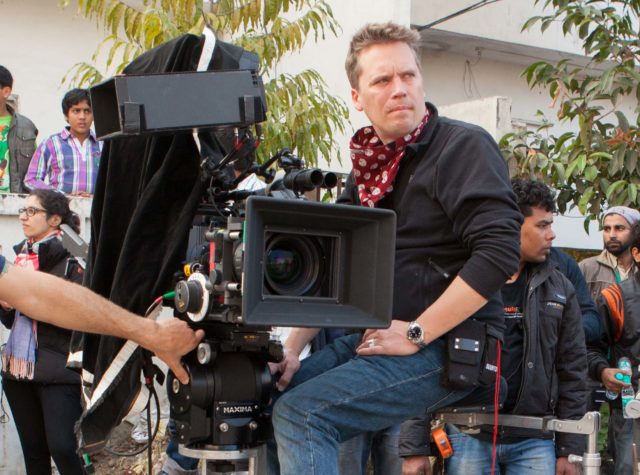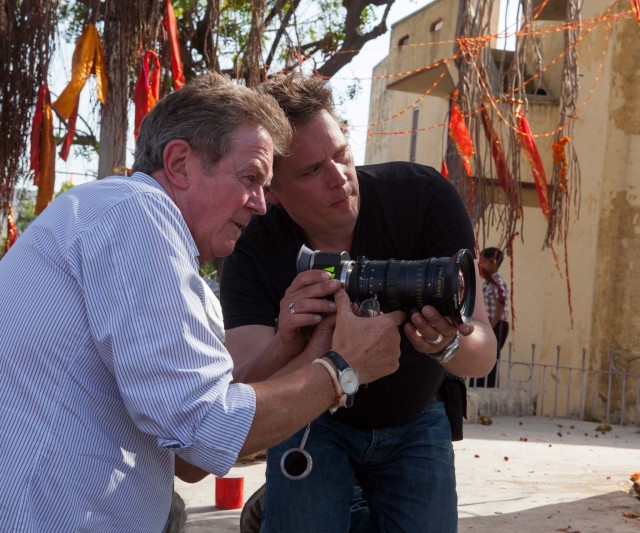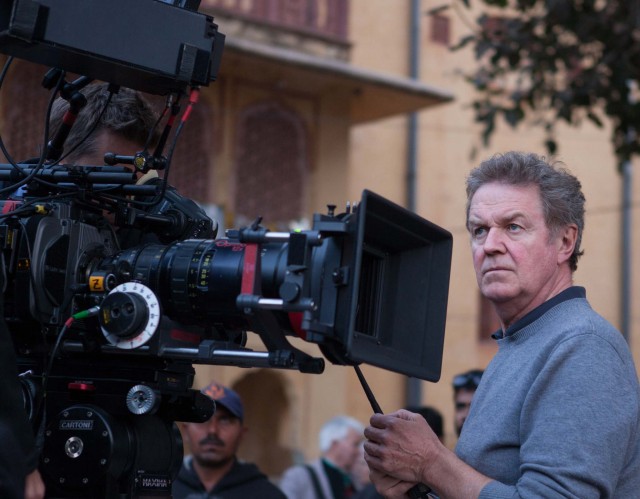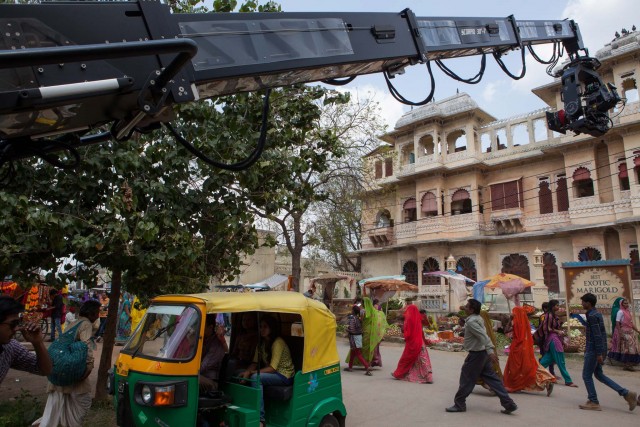A conversation with Ben Smithard, BSC about his work as Cinematographer on “The Second Best Exotic Marigold Hotel,” released in the USA on March 6, 2015.
JON FAUER
Tell us about the style of “Second Best Exotic Marigold Hotel” and how you and the director arrived at the look.
BEN SMITHARD
It involved lots of conversations. The biggest thing was actually going to India. Most of the preparation for the film and how it was going to look came about by just being there, taking photographs, going to locations, and discussing. I didn’t shoot the first “Best Exotic Marigold Hotel.” But, there was that reference. Obviously we were using some of the same locations, even though we were shooting on digital.
The experience of being in India was a big part of making the film. A lot of other films that shot were in England and other places, and the location was not a massive part of the look.
Being in India, the actual experience informs your viewpoint on how you would shoot the film. Because at the end of the day, we’re following characters in this story who are experiencing India in a similar way that I’m experiencing it.
We were shooting in the same place that they are supposed to be in. We’re not shooting Jaipur for Calcutta or Jaipur for Mumbai. The scenes in Mumbai were shot in Mumbai, the scenes that are set in Jaipur were shot in Jaipur. You get to understand what the characters are going through because you’re there, going through it with them. When all the cast and crew from England got there, along with a massive Indian crew, it almost felt as though we were part of the story.
Of course, John Madden, the director, and I discussed all the usual things you discuss when you’re making a film. You make reference to other films and photos.
This is a contemporary film set in a real place and we’re shooting it for real. I have a love of photojournalism and photography, so I was like a kid in a sweet shop when I got there. I was taking photographs of everything. The hardest thing about shooting this movie was trying to avoid the cultural clichés of India, photographically. That’s very difficult because India is one of the most photographed places in the world. Because the people generally are very happy for you to photograph them, it’s easy. The difficulty comes in making something completely original. So the look of this film is driven by the story. You follow the story, follow the characters. I tried to make it look interesting.
John Madden is not only a great director, he is an amazing craftsperson. I think that’s a great thing in a director, somebody who really understands the craft of filmmaking. When you’ve got an ally like that, there’s nothing you cannot do. You can achieve anything. I think there are a lot of directors who are very clever and very smart and they do understand it—especially the ones I’ve worked with. I had a great experience working with John. He’s very special and he’s very smart. He’s a very giving person and I loved every minute of the experience of making this movie.
JON FAUER
Tell me about camera choice on “Second Best Exotic Marigold Hotel.”
BEN SMITHARD
Originally there was a conversation about shooting film on the project. But we were in Jaipur and Udaipur, which is quite a long way away from the lab in Mumbai. Although they shot film on the first “Exotic Marigold Hotel” I had a bit of a concern about the reliability of the laboratory.
I shot my previous film, “Belle,” on the Sony F65. I think it was the first British feature film done on the F65, and I liked the look. When we moved away from film on the “Second Best Exotic Marigold Hotel” I decided on the F65 because I knew that we would be taking the cameras from London and shipping them to India. I was very happy with the camera and the rental company that I use, Movietech in Pinewood Studios, London. They are very reliable and the lenses from that company are amazing. They’re all really well looked after. My decision to shoot with the F65 was based mainly on the fact that I’d already shot a movie on it. I knew what I was getting with the camera.
JON FAUER
Movietech is John Venables and John Buckley, right?
BEN SMITHARD
That’s it. You know you’re going to get really good backup with them, which was important being in India. When I used the F65 on “Belle,” there were no technical hitches at all with the camera. It was completely reliable, and if you’re shooting in India, you need a reliable camera.
JON FAUER
How many cameras did you take?
BEN SMITHARD
We took three cameras. We shot with two and we had a spare body the whole time.
JON FAUER
What lenses did you use?
BEN SMITHARD
Our entire lens package came straight from “Belle.” I knew what I was getting. I used the whole range of Cooke S4 primes from 14 to 135 mm—the same set that I used on “Belle.” I also used the Angenieux 17-80, which is my personal favorite zoom lens. It’s very sharp. There’s a really nice look to it. I have that on my camera nearly all the time. I also had the Angenieux Optimo 24-290 and 28-76.
JON FAUER
How was the match between the Cooke S4 primes and the Angenieux zooms?
BEN SMITHARD
If you’re going to use a piece of very good glass like the Cooke S4 lenses, then you need a good zoom.
I like working on zooms as much as I can. I use the primes for handheld or Steadicam. I’ve never had any major problems trying to match them, to be honest. I like the Angenieux Zooms. I like the way they’re built. They are well-made, and well-constructed. If there’s a very slight color shift between zooms and primes, it’s easy to correct in the DI. That never really worries me.
JON FAUER
Did you use any diffusion or filtration?
BEN SMITHARD
That’s an interesting point. I sometimes used diffusion. John Madden, the director, wanted the film to look as realistic as possible, so I didn’t over-diffuse it. I used very light diffusion here and there, but nothing that was too noticeable.
Also, the atmosphere where we were shooting, Jaipur, in northwest of India, is a city in desert scrubland. If you can imagine, it’s a bit like California. You don’t really see blue skies very often because there’s dust in the air. When you’re in the city, you don’t see lots of white clouds. It’s very bright this time of year. But everything had a diffused quality already, so we didn’t need to over-diffuse the images with filters.
At night, it gets foggy, so night scenes don’t need diffusion on the lenses either. We did a lot of night shots, and around 2:00 to 4:00 in the morning that time of the year, there was a lot of rolling fog. It could really fog up our whole location. We were very lucky. In some scenes, the background looks like I filled it with smoke, but I didn’t. It’s actually fog. There were a couple of takes with people at night in front of really blown-out highlights from car headlights. But there wasn’t anything wrong with the camera. In India, many people just have their headlights on full-beam or they’re not adjusted very well. It’s quite foggy and dusty and the highlights bloom. There’s nothing you can do about that. That’s just India at night. I haven’t been to many places like that before.
JON FAUER
Can you give us an example of how you and John Madden worked together on a particular scene developing a shot or a look?
BEN SMITHARD
I can give you a general overview. This was a film consisting of many scenes with complicated camera moves and very good actors. I had worked with quite a few of them before. I operate “A” Camera (the main camera). I have done this on every movie I’ve made. It is a big job when you’re lighting as well. But it’s something I do and I enjoy.
In doing very complicated camera moves with famous actors, their positioning and blocking within the scene is crucial. You’re doing intricate movements around them and designing dolly moves. The thing is, John may be sitting at the monitor and I’d be either tracking left and then pushing into a two-shot or swinging over into a three-shot and then going into a single over-the-shoulder and then pushing in. As we were doing it, he’d understand exactly, always, all the time. He’d know precisely what my problem was and he’d say something like, “Okay, Maggie, you just need to move a little bit to the left and then when the camera’s there, you just move forward a couple of feet so you open up onto that character.” He’s awesome. And this would happen on a daily basis because John just gets it, he sees it, and he makes my job so much easier. If I had to do all of that myself, it would take so much more energy. And then what happens is you get it all lined up and it’s rehearsed really well and you’ve got it and you finally realize, “Oh, you know what? I’ve got to light this bloody scene.” So if you’ve got a director who’s just brilliant like John is, you can do all that because he’s guiding you and helping. It was a perfect collaboration.
The actors were all great. I’ve worked with Judy Dench three to four times, and I’ve worked with Celia Imrie. I’ve worked with Bill Nighy. I hadn’t worked with Richard Gere or Maggie Smith. But when you’ve got that caliber of actors, even though they’re all really nice and easy, you’ve still got to position them where you want them to be. John Madden came from theater and television, and he excels at being able to move the actors into the right positions for the shot to work.
John also understands light. It is quite unique for a director to really get what you’re trying to do with the light, and that makes a huge difference to a cinematographer. For example, you walk into a location, and as a cameraman you naturally want to put the camera in a place that takes advantage of the natural light. You gravitate to where the camera should be. John always understands that. He doesn’t push you into a part of the location that doesn’t really work for the available light. Of course, there were situations, especially in the actual hotel, where we couldn’t shoot at the right time of day to make it work because the schedule wouldn’t allow it. But in general, I wouldn’t be saying to the director, “This is going to look much better here because the light is coming from that direction from behind that building and backlit there.” He understands immediately what you’re trying to do to make the image look much better.
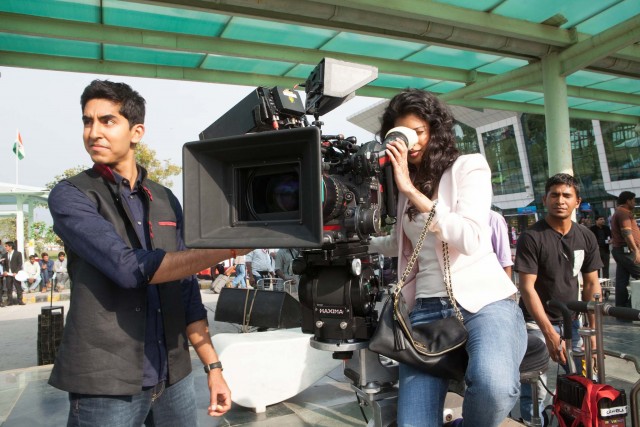
Dev Patel and Tina Desai on the set of THE SECOND BEST EXOTIC MARIGOLD HOTEL. Photo: Laurie Sparham. © Fox Searchlight.
JON FAUER
It looks like you use a Cartoni head.
BEN SMITHARD
Yes, it’s a Cartoni Maxima head, and I used it for the first time on “Belle.” I really liked it. It’s a bit beefier and stronger than the others. It’s really smooth. When you’ve got an F65 with a big Angenieux zoom on, it’s better because it can take a bit more weight.
Now I own it. When I finished “Marigold Hotel,” I bought it off Movietech. It lives upstairs in my office in my house, three stories up. It’s a bit heavy with the box that it comes in, climbing up all those stairs. I take the head out the box and carry it up separately. But it’s a great head.
JON FAUER
Did you have a DIT?
BEN SMITHARD
Yes, we had a DIT who came to India. We had a data wrangler as well. An issue I have on pretty much every film I do is that since I’m operating “A” Camera, I don’t get to sit and watch monitors on set. People ask me all the time whether I am interested in grading on the set. I’m not really, to be honest. Because grading should be done by the colorist, at the end, in a suite that probably cost half a million quid in a perfect environment. The colorist is very knowledgeable and very talented in their job. I think if I didn’t operate the camera, maybe I would be sitting in a tent playing around with color wheels and trying to get a certain look. But I can’t do that. I just want to get the densities and contrast right from shot to shot. If you do a location picture, one minute you’re inside, next minute you’re outside, next you’re a night exterior, and then a dark, day interior. I don’t know how you could set look-up tables for all those locations. So I don’t get into it. The colorists all say, “Well, why would you?” And then we spend maybe two or three weeks to grade at the end.
The key thing is that I got the right contrast density in the dailies. Some cinematographers, and I applaud them, set the look to be as a close to how they want it while they’re shooting, so everyone gets used to it in the offline and there are no surprises when you to grade the final film. But the truth is I’ve never had an issue with the final grade anywhere. I just go in there and do what I always thought the film should be like anyway.
JON FAUER
Did you use the F65 for everything?
BEN SMITHARD
I also took a RED Scarlet with me. I used it for interior car scenes, because it’s smaller or I could make it really small. The cars in the film were tiny. They’re mostly night scenes. They matched nicely. In the digital world, the differences are quite subtle. It’s not like film, where there are big differences between the film stocks.
JON FAUER
What about the final DI grading? Where was it done?
BEN SMITHARD
It was done at Molinare, which is the company that I use often, with the same grader, Gareth Spensley. He graded “Belle,” and other feature films and TV projects that I’ve done. I trust the company. They’re very good. Their main DI suite is one of the best in London. We graded in that theater, which has a very big screen. We graded on Baselight. Gareth is a genius with that piece of machinery and I always feel very comfortable working with Molinare. John was very happy with them.
JON FAUER
Did you grade in 4K or 2K?
BEN SMITHARD
I graded in 2K. But they conformed in 4K. The 4K conform was there for us to use, if we ever needed it for more detail or for compositing. But ultimately, the project was 2K.
JON FAUER
Did you bring your key crew members from England?
BEN SMITHARD
Yes. I took a focus puller, second AC, Steadicam operator (Alastair Rae), DIT, key grip, and data wrangler from England. We had an Indian gaffer. He came highly recommended from somebody I’d worked with before, and he was a very good gaffer.
JON FAUER
How big was the total crew?
BEN SMITHARD
The crew was massive. I would check the call sheet every day just to see how many people there were. When you added it up, it would very rarely be fewer than 400 people. That’s cast and crew. Sometimes with extras and so on, it went up to a thousand. There were a lot of people. When I first arrived, I wondered, “Wow. How do you work on a film set with so many people?”
But ultimately, the dynamics of the movie process isn’t that much different because all those people are spread out all over the place. There’s definitely more people on an Indian film set than in the West, for sure. But it was manageable, easy to get along, and I enjoyed pretty much all of it.
JON FAUER
Did you work with a local production services and house?
BEN SMITHARD
The production service company was called India Tech One. They were really helpful. The cameras and all the grip gear came from London. They all got shipped over. The dollies and track and tripods and all the grip gear came from London. The cranes and remote heads came from Mumbai (Scorpio from Servicevision).
Our gaffer owned the lighting company in Mumbai. It was was top-notch. We had every type of light. We had moving lights on all the dance numbers at the end. At the wedding party, we had a massive amount of light. Some of the night shoots had really big lighting set-ups. I planned the lighting like I do on every film. If you plan it to the very last detail, it just makes things so much easier when you get there and you just go through as much detail with the director as possible.
We were shooting in a great big colonial fort with big, high walls all the way around it. You could walk all the way round this huge house inside the fort. The surrounding walls of the fort were 30 or 40 feet high and about 15 feet wide. So we could put our lights all the way around, and whichever way we were pointing, we could turn the lights on or off — and take advantage of backlight and three-quarter backlight or whatever. There were always 25 to 30 electricians on every day. So when you ask to move five 18Ks, it gets done very quickly. That’s a big move. We had every HMI from 200 watts to 18K. We had at least two ARRI Maxes and maybe more.
Because it was a contemporary film, I didn’t have any reservations about using all types of light. Apart from LEDs. I haven’t really gotten into LEDs yet. For night interiors we used Dedolights, Kino Flos and small Fresnel units.
Whereas the film I’m doing now, “The Dresser,” is set in 1941. There were no HMI, no Kino Flos, no LED lights. There were just tungsten lamps. It just works for that type of look to use tungsten lamps.
JON FAUER
I assume that on “My Week with Marilyn” you did something similar. You avoided modern lights?
BEN SMITHARD
Yes, for sure. Especially the studio work. It was all tungsten. I think I probably used some Kino Flos, but mainly we had tungsten lights. For the exteriors I would have used HMIs for sure. But inside of the studio, I just love the look of tungsten light.
The film I’m doing at the moment, “The Dresser,” is obviously set in the theater. We’ve managed to get a DC Carbon Arc Follow Spot. There’s one in the country. They brought it into the studio the other day to show us. It was built in 1936. We’re using it, and it works. The guys came with the carbon arcs and they got the DC power supply and the lamp to work. It’s a nice light. It’s what they would have used in a theater in England in 1941. It’s quite amazing and looks beautiful. It’s got a little funnel on the top and smoke comes out of it. It has a vintage theatrical look, you know, the edges have color fringing and there are daylight carbons and tungsten carbons.
Because “The Dresser” is all set backstage and onstage, there are no exterior scenes. It all takes place over one night. So that DC Carbon Arc, with its daylight carbon, is the only daylight we’re using on the whole film.
JON FAUER
What lenses did you use on “Marilyn?”
BEN SMITHARD
I used Cooke S5/i on “Marilyn”. That was the first time they’d been used on a film. They looked great. But lately, I think people are obsessed by using old lenses.
JON FAUER
What’s your feeling about that?
BEN SMITHARD
I did a big commercial in Argentina at the end of last year and I wanted to shoot Anamorphic on the Alexa. I was offered a set of vintage Kowa Anamorphics from Musitelli, the rental house in Uruguay. They had a really interesting look. One of them was just unusable because it just wouldn’t focus at any T-stop. As there were only four in the set, I had three lenses to shoot with. But thosee three were great. I think on my next film I probably would like to shoot Anamorphic.
JON FAUER
Ben, thank you so much for your time. It’s been a fascinating discussion.
BEN SMITHARD
You’re very welcome, Jon. Cheers, mate.
Photos: Laurie Sparham. © 2014 Twentieth Century Fox Film Corporation.

